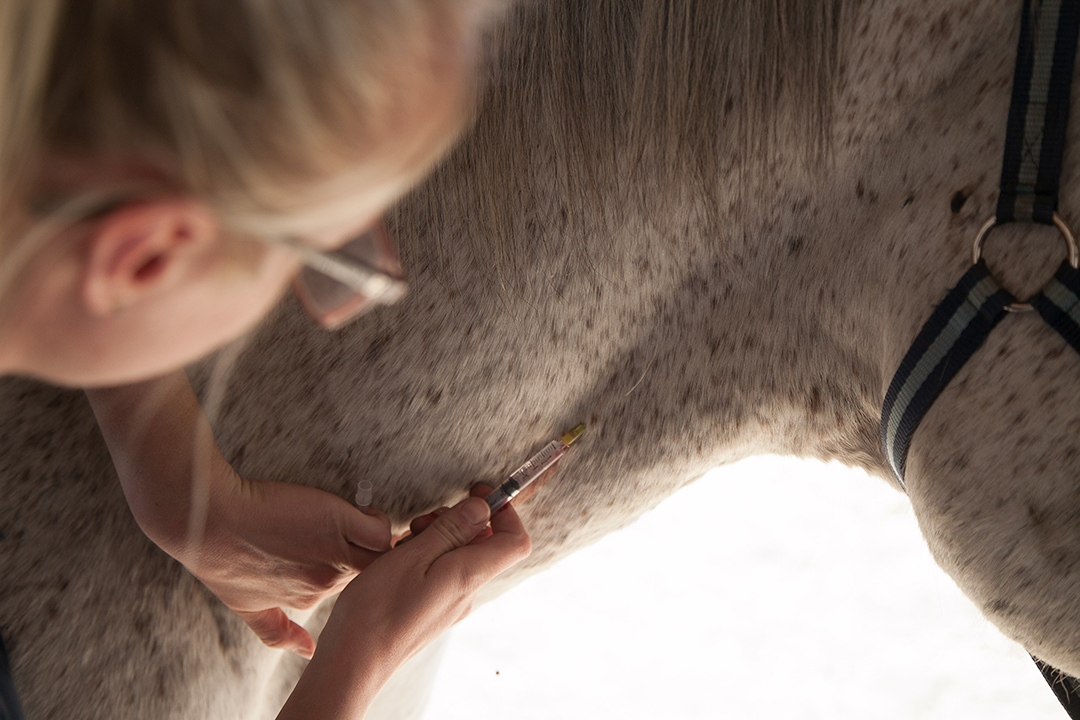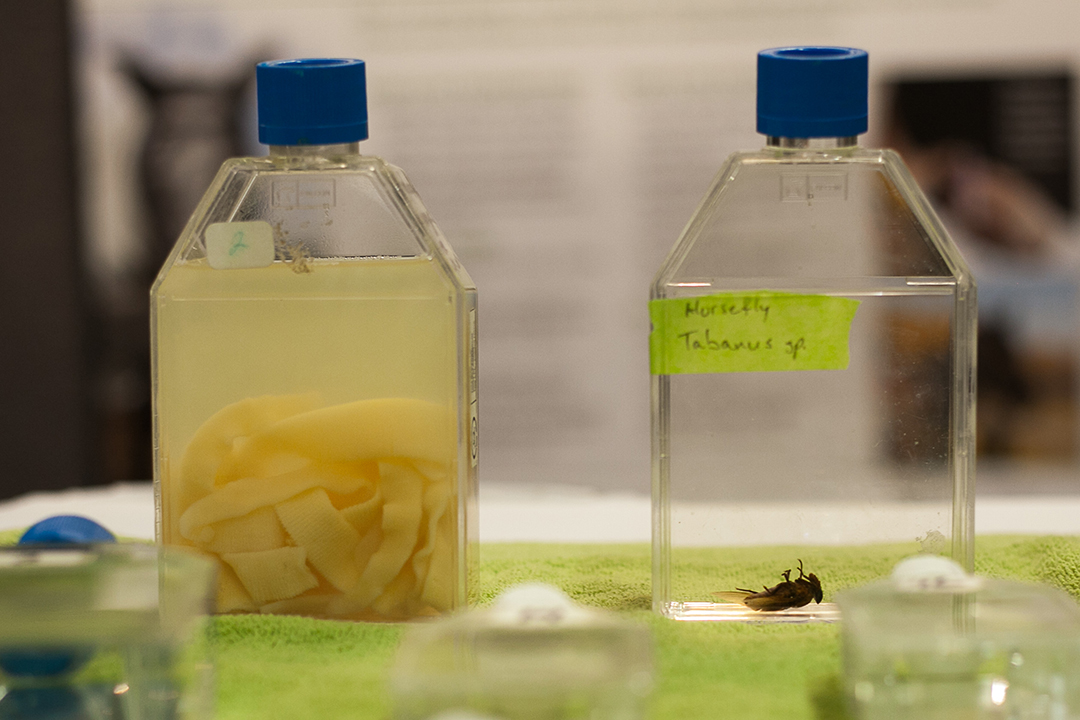General information
It's recommended that horse owners book an annual equine wellness appointment with their veterinarian every spring before the vector season begins and before equine competitions and events resume. The annual wellness appointment usually includes:
- a physical examination
- annual vaccinations
- a dental examination and teeth floating
- a fecal egg count (FEC) exam and targeted deworming
- sheath cleaning (for stallions and geldings)
Vaccinations
Core vaccinations

Every horse is an individual, so please discuss your animal’s specific needs and your region’s specific vaccine requirements with your veterinarian.
Core vaccines are important for all horses in a specific area, regardless of their lifestyle.
Tetanus toxoid
- Tetanus causes difficulty eating and swallowing, lockjaw and muscle rigidity.
- Horses are very susceptible to disease.
- Its most common infection route is through a puncture wound.
- Available as a combination vaccine or on its own.
West Nile virus (WNV)
- Mosquito-transmitted disease that causes a range of symptoms from flu-like symptoms to neurological disease.
- No treatment other than supportive care.
- Available as a combination vaccine or on its own.
Eastern and western equine encephalitis (EEE and WEE)
- Mosquito-transmitted diseases that cause severe neurological signs.
- Consistent and widespread vaccination have almost eradicated these diseases in North America.
- Available as combination vaccines only.
Rabies
- Virus is transmitted from the bite, or saliva, of an infected animal.
- The disease has three forms:
- furious (causing aggressive behaviour)
- dumb (causing depression)
- paralytic (causing paralysis)
- Horses are rarely infected, but the exposure of an unvaccinated animal to a rabid animal results in a long period of quarantine (60 days) or immediate euthanasia.
- Vaccine available on its own and must be administered by a veterinarian.
Risk-based vaccines
Veterinarians recommend these vaccines based on the lifestyle of the horse and the risk of contracting each disease.
Influenza (flu)
- Flu virus causes fever, nasal discharge, lethargy and a dry cough
- Highly contagious among horses, especially young ones
- Different vaccines to target European and North American virus strains
- Vaccine recommended for horses that travel or are stabled in a facility where horses are moving in and out
- Available alone as an intranasal vaccine or in combination vaccines
Equine herpesvirus 1 and 4 (rhino)
- Equine herpesvirus causes rhinopneumonitis (rhino), a highly contagious viral disease
- Most commonly causes respiratory symptoms in horses, but it also causes abortions in pregnant mares and neurological signs
- Once a horse is infected, the virus can remain latent and then reappear when the horse is under stress
- Vaccines do not protect against the disease’s neurological form
- Vaccine recommended for horses that travel or are stabled in a facility where horses are moving in and out
- Available alone as an intramuscular vaccine or in combination vaccines
- Specific vaccine for pregnant mares
Strangles
- Highly contagious disease among horses, especially young animals on breeding farms. Its clinical signs include:
- fever
- thick, white nasal discharge
- abscesses of the lymph nodes around the head
- Since some horses can carry the disease and spread it to others, the vaccine is recommended for horses that travel or are stabled in a facility where horses are moving in and out.
- Due to the risk of fatal side effects, exposed horses should not receive the strangles vaccine for at least five to 10 years after exposure unless an analysis of antibody titres (concentration levels) has been completed.
- Only available on its own as an intranasal vaccine
Vaccine combinations
Three-way plus WNV
- Tetanus toxoid
- Western equine encephalitis (WEE)
- Eastern equine encephalitis (EEE)
- West Nile virus (WNV)
- Given intramuscularly with a booster shot one month after initial dose
- In subsequent years, given as an annual vaccine each spring before mosquito season
Five-way plus WNV
- Tetanus toxoid
- Western equine encephalitis (WEE)
- Eastern equine encephalitis (EEE)
- Equine influenza virus (flu)
- Equine herpesvirus 1 and 4 (rhino)
- West Nile virus (WNV)
- Given intramuscularly with a booster shot one month after initial dose
- In subsequent years, given as an annual vaccine each spring before mosquito season
Two-way (flu/rhino)
- Equine influenza virus (flu)
- Equine herpesvirus 1 and 4 (rhino)
- Given intramuscularly with a booster shot one month after initial dose. Subsequent vaccines are given every six months (spring and fall).
- Different versions of this vaccine for different strains of flu:
- Version 1: Given to horses that are at risk for flu/rhino but not in contact with European horses. Fall
“booster” if horse was given five-way + WNV in spring. - Version 2: Given to horses that are at risk for flu/rhino but not in contact with European horses. Doesn’t work as “booster” to five-way + WNV vaccine combination.
- Version 3: Given to horses that are at risk for flu/rhino and are in contact with European horses. Doesn’t work as “booster” to five-way + WNV vaccine combination.
- Version 1: Given to horses that are at risk for flu/rhino but not in contact with European horses. Fall
Individual vaccines
Rabies
- Given intramuscularly with an annual booster
Tetanus toxoid
- Given intramuscularly with a booster shot one month after initial dose. Annual vaccine in subsequent years.
- Since most horses receive an annual tetanus vaccine in combination with other vaccines, tetanus toxoid is usually only given on its own to horses that have obtained wounds and had their last tetanus booster more than six months earlier.
Equine herpesvirus
- Given intramuscularly to pregnant mares at five, seven and nine months of gestation
Equine influenza (flu)
- Given intranasally with a booster shot every six months (spring and fall).
- Vaccine does not need to be given if the horse received a flu/rhino combination vaccine.
Strangles
- Given intranasally with an annual booster shot
Ask your veterinarian for advice on what specific products to use.
Deworming
Key facts

Every horse is an individual, so please consult your veterinarian to determine the best deworming strategy for your horse.
Horses' parasite burdens
- Every horse is an individual and different horses in the same herd will have different worm (parasite) burdens.
- While most horses shed very few worm eggs, a small number of horses shed high numbers of eggs and are more responsible for infecting the rest of the herd.
- It’s important to deworm horses strategically so owners appropriately target their high shedding horses and not overuse dewormers.
Resistance
Overuse of deworming products leads to resistance. Worms can develop genes that allow them to become resistant to the dewormers — making the medication ineffective.
Resistance limits our ability to treat horses with worm problems. These issues can lead to severe colic and death in affected horses.
Deworming recommendations
- Most horses only need to be dewormed once or twice a year. Before deworming in the spring, we recommend having a fecal egg count (FEC) done. This procedure allows us to measure the number of worm eggs a horse is shedding in its feces. Based on the results, we will recommend whether you need to deworm your horse.
- We recommend that horses be dewormed in the late fall, after a hard frost, with an appropriate deworming product. Your local veterinarian can advise you about what deworming product to use in the fall based on the common parasites in your area.
- We strongly recommend conducting a second fecal egg count in the fall, but many owners elect not to do this second procedure. A fecal egg count is included in the spring herd health packages offered at many local boarding facilities.
- Pregnant mares should be dewormed in the spring before they foal with a dewormer chosen based on the results of a fecal egg count. Mothers should be dewormed with an ivermectin product 24 hours after foaling.
- Foals need much more frequent deworming than other horses. They should first be dewormed around two months of age with fenbendazole, and then retreated with this product every two months until they are yearlings. In the prairie provinces, foals do not need to be dewormed through the winter when temperatures are below freezing.
- Foals should be dewormed with an ivermectin-type product around 12 months of age and then every three to four months with a product chosen based on their fecal egg counts.
Common worms
Roundworms (Parascaris equorum)
- Most common in horses less than one year old and in very old animals due to decreased immunity
- Migrate through the trachea and live in the small intestine
- In young horses, roundworms cause poor growth and development as well as respiratory signs. Young animals with very heavy burdens can have obstructed intestines— leading to colic and possibly death.
- Older affected horses may have a poor hair coat, weight loss or decreased performance
Bloodworms (Strongylus vulgaris)
- Can migrate through the arteries around the large intestines and cause colic
- Bloodworms used to be a major problem in horses, but their occurrence and significance has decreased with appropriate deworming
Cyathostomins
- Live in the large intestine and migrate into the wall of the intestine
- Cyathostomins cause severe gastrointestinal signs such as decreased appetite and diarrhea
- Resistance to dewormers is increasing in these worms, so targeted deworming is especially important
Pinworms (Oxyuris equi)
- Most common in horses less than two years old or in horses with poor management
- Worms live in the large intestine, but they deposit their eggs around the horse’s anus — causing the horse to have an itchy hind end.
- It’s difficult to treat and control pinworms so good horse and pasture management is important
Tapeworms
- Tapeworms are uncommon on the prairies, but the most common tapeworm in Canada is called Anoplocephala perfoliata. Since these worms spend part of their life living on mites, they are difficult to control.
- Tapeworms don’t seem to cause much disease in horses. While colic is considered a risk with this type of worm, the incidence is quite low.
Bots flies (Gasterophilus)
- Bot flies lay their eggs on the horse’s coat in late summer and early fall. The eggs show up as small yellow specks, mainly on the horses’ legs.
- Horses ingest bot eggs while licking or scratching their legs, then the eggs develop into larvae in the equine stomach and small intestine. The larvae are passed out through feces and hatch in the spring.
- Bots rarely cause clinical signs in horses, but they can cause gastric ulcers.
Common dewormers
Ask your veterinarian for advice on what specific products to use
Fenbendazole: Targets roundworms, bloodworms and pinworms
Ivermectin: Targets all parasites except tapeworms. However, resistance to ivermectin is high in roundworms.
Ivermectin and praziquantel: Targets all parasites. However, resistance to ivermectin is high in roundworms.
Moxidectin: Targets all parasites except tapeworms. However, resistance to moxidectin is high in roundworms.
Moxidectin and praziquantel: Targets all parasites. However, resistance to moxidectin is high in roundworms.
Pyrantel: Targets bloodworms, pinworms and roundworms
What should I do?
Call your veterinarian to book an annual equine wellness appointment for your horse and discuss the best vaccination and deworming strategies for your animal.
EquineED Talk
As part of the WCVM's EquineED Talks series for the horse community, WCVM clinical associate Dr. Nora Chavarria gave the following presentation on equine spring wellness.
News
Horse Health | WCVM
Loading...

